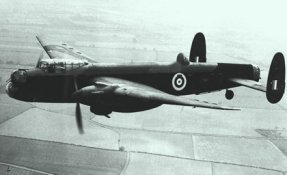
Avro Manchester
Overshadowed by the immortal Lancaster that replaced it in service, the Manchester was plagued by the unreliability of its Rolls-Royce Vulture engine. First flown in 1940, the Manchester had a brief operational career, and the aircraft's last combat mission was flown in mid-1942. The real fame of the aircraft was that, with the marriage of its airframe and four Rolls-Royce Merlin engines, it became the Avro Lancaster.
Had the Manchester been powered by a viable engine, its career might have been far longer. However,it was stuck with the dubious Rolls-Royce Vulture, a mighty V-24 in-line engine that failed to deliver the power intended, and also suffered from chronic reliability problems. The engine was also intended for a rival Handley Page design which was later cancelled.
The first Manchester protoype flew in July 1939, and a second in 1940. The Air Ministry ordered 200, and then 400. After flight trials, the wing span was increased by three metres and a central fin was added between the two endplate fins(later deleted in theMk IA). The first squadron, No. 207, was formed in November 1940 and carried out its first mission in February 1941. nine bomber squadronsreceived the aircraft, and one flight of Coastal Command. The Manchester was not really a success in combat, suffering from a number of airframe faults as well as endless failures of the Vulture engine.
The last Bomber Command operation with the aircraft took place over Bremen on 25/26 June 1942. Only 202 Manchesters had been built, of which about 40 percent were lost on operations and 25 percent in accidents.
Were it not for the Manchester, Avro might not have built the Lancaster, probably the best night bomber of the war. The type also gave Bomber Command useful ideas about how its future bomber aircraft should look.
 |
 |
| The Manchester might have been a useful design, having a potent defensive and offensive armament, but the Vulture engine spent more time under repair than in service. One of the best points of Manchester was the good coverage of its defensive armament, with tail, nose and dorsal gun turrets. |
First flown in 1940, the Manchester had a brief operational career, and the aircraft's last combat mission was flown in mid-1942. |
|
Avro Manchester (Technical Specification) |
| Role |
Twin-engined medium bomber |
| Manufacturer |
Avro |
| Maximum Speed |
426 kmh (264 mph) |
| Maximum Range |
2,623 km (1,625 miles) |
| Ceiling |
5,850 meters (19,200 feet) |
Weight
Empty
Maximum Takeoff |
13,350 kg (29,370 lbs)
25,401 kg (55,880 lbs) |
Dimensions
Wingspan
Length
Height
Wing Area |
27.46 meters (90 ft, 1 in)
21.13 meters (69 ft, 4 in)
5.94 meters (19 ft, 6 in)
105.63 square meters (1,137 sq ft) |
| Engines |
Two Rolls-Royce Vulture 24-cylinder engines each providing 1312-kW (1,760 hp) |
| Armament |
Two 7.7mm machine guns in the nose turret and mid-upper turret.
Four 7.7mm machine guns in the rear turret.
4,695 kg (10,330 lbs) of bombs or incendiaries |
| Number Built |
202 |
Photo Gallery
Click here to submit your photo
| Have A Passion For Aircraft? |
Subscribe to our 14 series FREE newsletter
delivered weekly on World War 2 Aircraft factfile... |
| NB:- We hate spam as much as you do, so your email address will NEVER be shared with or sold to anyone else. That's a Guarantee. |
|
|




